ONLINE NEWS: USM'S DR NASHA RODZIADI KHAW ON RESEARCHING ANCIENT CIVILISATIONS AND PRESERVING MALAYSIA'S RICH HISTORY
Options The Edge
USM's Dr Nasha Rodziadi Khaw on researching ancient civilisations and preserving Malaysia’s rich history
By Diana Khoo | 14 July 2024
His team recently unearthed a life-size meditating Buddha structure in Bukit Choras, Kedah.
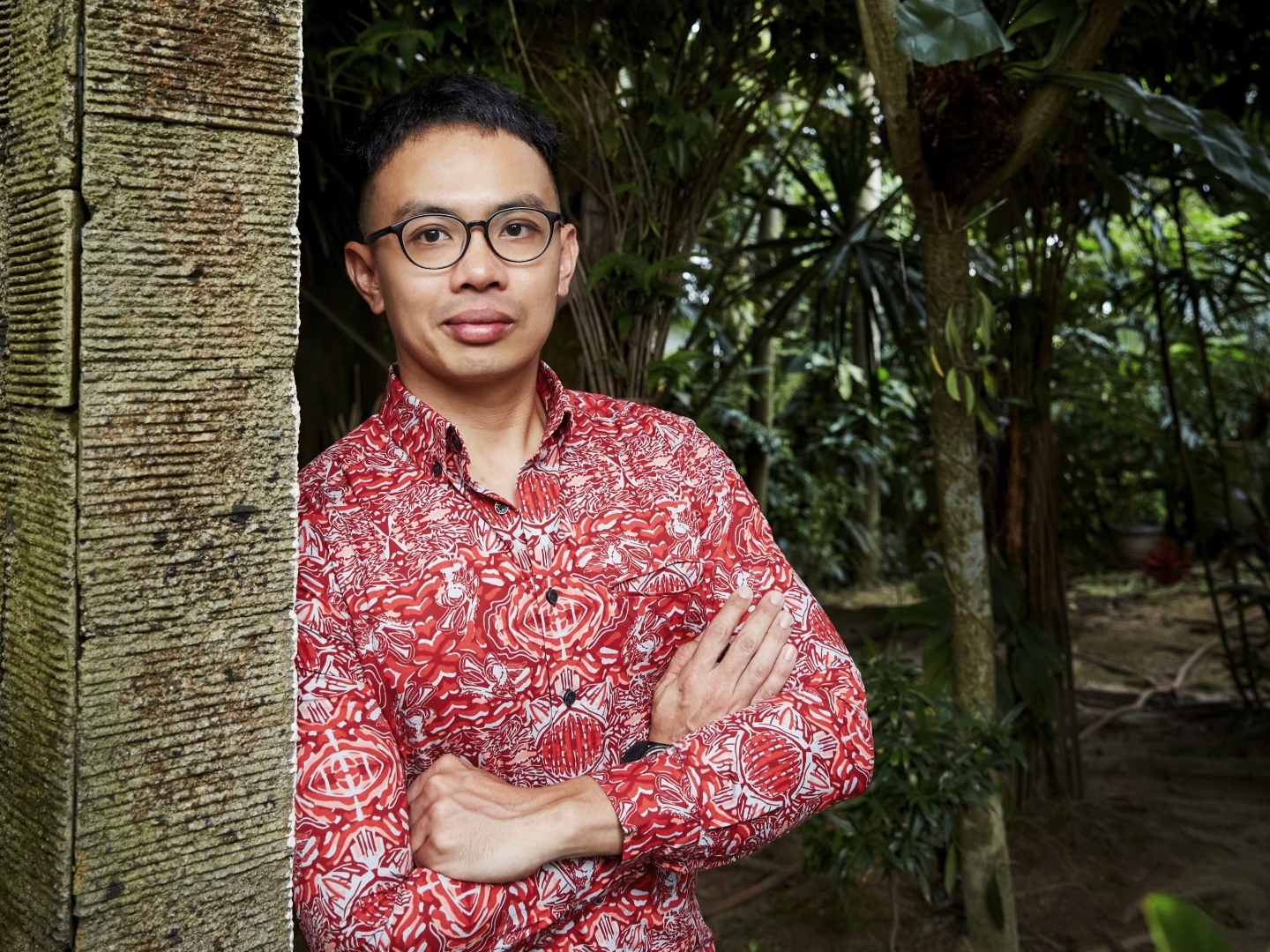
Nasha: It then dawned on me just how privileged those in the field of archaeology really are, being able to directly connect with ancient society through the artefacts they left, being separated from them only by time itself (Photo: SooPhye)
Mention archaeology and, chances are, most of us would immediately think of a figure such as Indiana Jones, fictional protagonist of the successful 1980s hit movies Raiders of the Lost Ark, The Temple of Doom and The Last Crusade. With Harrison Ford playing the titular role to unmatched success over the decades (even up to its most recent instalment, Dial of Destiny, which premiered just last year and necessitated the use of CGI to help “de-age” the octogenarian Ford), Dr Henry Walton “Indiana” Jones, Jr remains the ultimate representation — albeit a Hollywood version — of a person who excavates sites, analyses artefacts, gives lectures when he is back at work in a grand old university somewhere, and somehow succeeds in unearthing priceless relics in the process.
It is the notion of this celluloid caricature that makes archaeologist Dr Nasha Rodziadi Khaw, 39, chuckle.
“We certainly don’t go around smashing artefacts to chase after a single piece of treasure,” he says. “In archaeology, every single item, a shred or sliver, no matter how small, is of utmost importance, as is data. I guess the idea of an Indiana Jones type of character helps the general public understand what we do, but what you see in the movies is really just the tip of the iceberg. In reality, excavations and explorations form only a very small part of archaeological work. Most of our time is spent in the library or laboratory, and making groundbreaking discoveries is very rare!”
History + his story
It might surprise people that Nasha, a faculty member with Universiti Sains Malaysia’s (USM) Centre for Archaeology Research, was never seduced by the allure of ancient civilisations and societies such as the Egyptians, Olmec and Maya. Instead, his heart was always focused on his very own backyard.
“I remember always being intrigued about the ancient history of Kedah Tua (“Old Kedah”), even as a child. In fact, I can even remember exactly when my curiosity in Kedahan history came about; I must have been six or seven when I came across some of my older brother’s books and reading materials. Somehow, the unique names of these old kingdoms piqued my interest and I became hungry to know more. When I entered primary school, I remember always taking my siblings’ secondary school history textbooks to read, after which I would ring up my cousins and aunties to ask endless questions about whatever caught my attention.”
Nasha’s obsession with local and regional history was cemented in his teens.
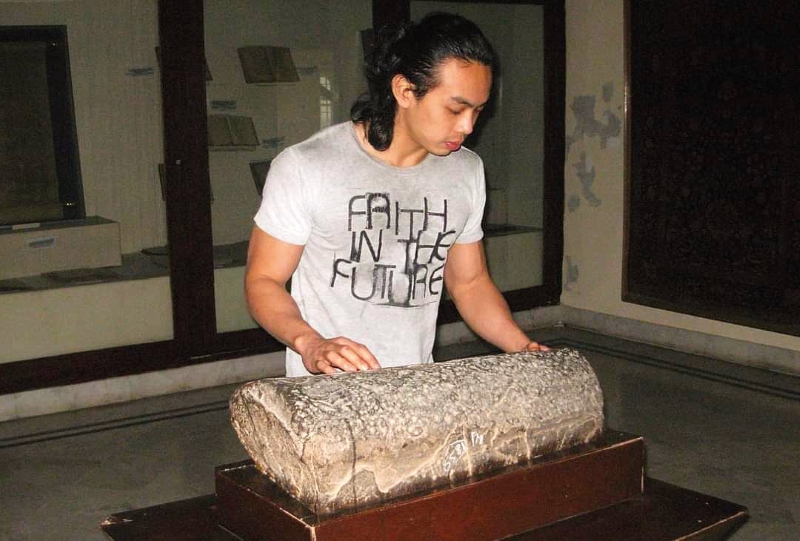
In Peshawar Museum, Pakistan (Photo: Dr Nasha Rodziadi Khaw)
“It was between 1998 and 2000,” he nods. “I remember how fascinated I was with the lessons regarding the pre-colonial history of Southeast Asia. Up until now, I still cannot forget all that the teachers taught us about the Kingdom of Funan, and how its agricultural society in the hinterland interacted with traders in the coastal areas. I also noticed that much had been discussed about the Sultanate of Melaka. But it didn’t escape my attention that very little was taught about what happened before the 15th century CE.”
Inquisitive by nature, Nasha immediately set about doing his own reading and research on Malaysia’s pre-Melakan history.
“I was extremely curious, as I noticed that Melaka [had been in existence] for less than 120 years, yet so much had been published about it — whereas I could barely find a few paragraphs written about the Bujang Valley, Kedah Tua or anything that existed prior.”
Naturally, history and archaeology were the top choices when the time came for Nasha to start charting his career path. Bright and studious, he scored straight As for all eight of his PMR papers — a result that would normally have any teen rejoicing.
“Owing to the good results, I had no choice but to be placed in the science stream. I regretted going along with it and forgoing my childhood ambition and true passion.”
As the saying goes, however, where there’s a will, there’s a way. Or as the Malays so poetically phrase it, “di mana ada kemahuan, di situ ada jalan”.
It was upon enrolling in USM’s BSc (Hons) degree programme in pure chemistry that Nasha was afforded the option to take 16 credit hours of minor courses. To his elation, archaeology was one of them. “Without thinking twice, I signed up immediately for my first year as an undergrad,” he beams. “I never thought that after so long, I would be able to live my childhood dream.”
And just as passion fuels purpose, Nasha, naturally, threw himself into his studies.
“I worked extra hard, learning and reading far more than required and had my first research paper on Kedah Tua published in 2007. The following year, I immediately set about obtaining my master’s in archaeology.”
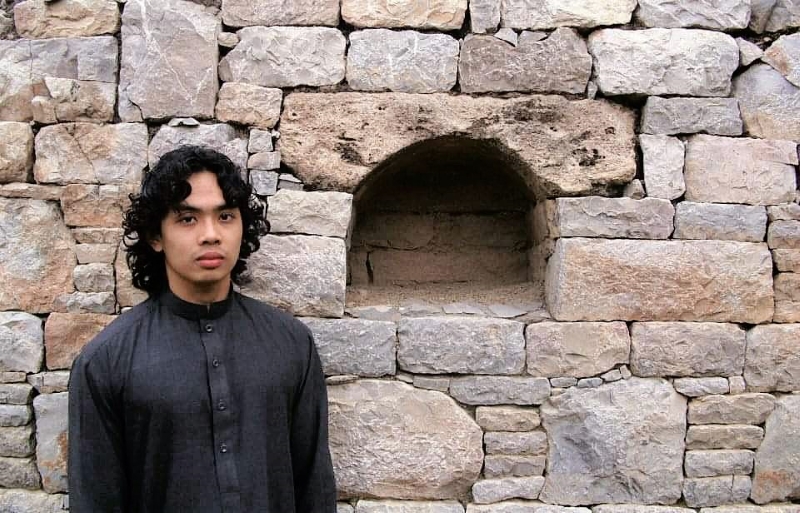
As a PhD student abroad (Photo: Dr Nasha Rodziadi Khaw)
From literature to reality
One of three boys born to a government servant father and a homemaker mother in Butterworth, Nasha has fond memories of his wholesome childhood.
“My father worked as an assistant pharmacist in a hospital and I was the quiet, bookish child while my brothers were into sports, music and outdoor activities. I spent most of my time indoors reading but I did enjoy gardening … I still do.”
Describing himself as critical, inquisitive and opinionated, Nasha loved learning things that did not necessarily fall within the school curriculum, such as foreign languages and history.
“Politics also intrigued me and I loved reading about the goings-on in other nations. You could say nothing has changed very much except that I am definitely more into gym and fitness now.”
It might surprise many that biceps and a strong core are actually needed in archaeology. A recent visit to a current dig in Kedah required a half-hour climb uphill, through thick jungle, just to reach the excavation site.
“And don’t forget all the equipment we have to carry up and down, besides daily provisions like water and lunch,” he grins. “And imagine if you find something significant and made of carved stone?”
Despite the Hollywood glamour proffered by Ford’s whip-wielding, fedora-wearing character, Nasha assures that the reality is far different.
“It’s the tropics … There are mosquitoes aplenty, not to mention several other things that bite and sting,” he laughs. “Don’t even ask me where the washrooms are. Thankfully, we have a wonderful relationship with the nearby village and its Tok Bilal, and can easily make the trek up and down should we need to use the facilities.”
Despite the literal sweat, tears and hardship of his chosen profession, Nasha’s joy is palpable and visible. Ever since he first visited the legendary Bujang Valley in 2006, that passion has burnt as brightly as ever.
“I had come to gather information for an assignment I was doing on the Candi Bukit Batu Pahat, located within the compound of the Bujang Valley Archaeological Museum. It was during this visit that I had a personal experience of viewing, touching and appreciating the real and tangible vestiges of a society that had [disappeared] for more than 1,000 years, something old school textbooks only hinted at.
“We were able to really study materials that were the actual remnants of a long-lost culture and became first-hand witnesses to all that had happened so many centuries ago. It then dawned on me just how privileged those in the field of archaeology really are, being able to directly connect with ancient society through the artefacts they left, being separated from them only by time itself.”
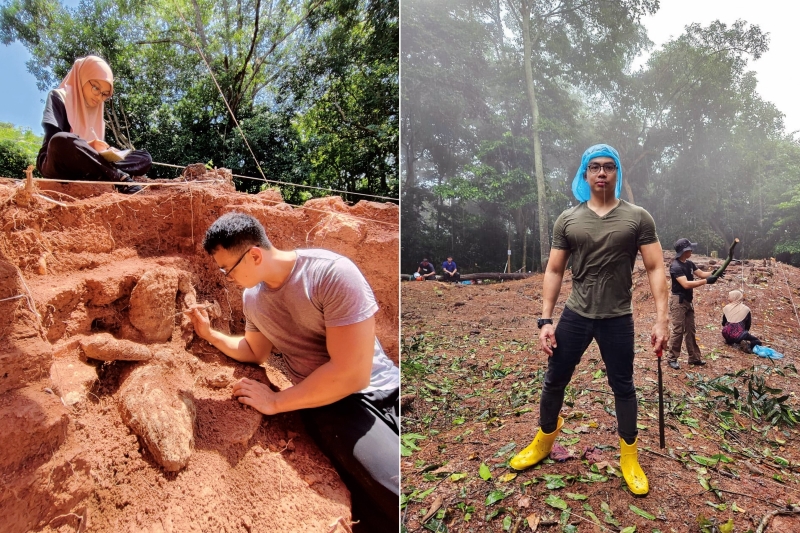
Despite the literal sweat, tears and hardship of his chosen profession, Nasha’s joy is palpable and visible (Photo: Dr Nasha Rodziadi Khaw)
Season of revival
Archaeology buffs will tell you that the three key sites in the Bujang Valley are concentrated around Sungai Bujang, Sungai Muda and Sungai Batu, all of which rank among Southeast Asia’s oldest Hindu-Buddhist locations before the advent of Islam in the Malay Peninsula from the 14th century onwards. So, the mere mention of Bukit Choras, an isolated spot and much farther away from the famous trio, is unexpected and exciting.
The lands surrounding Gunung Jerai, long used by ancient mariners on the spice routes as a landmark, have always been an important and strategic port and place of commerce. The great Chola kingdom of India had referred to Kedah as Kadaram, and Tang Dynasty monks had written about a northern trading port in the Malay Archipelago called Ka-Cha. Also cited in the famous Malay chronicle of Hikayat Merong Mahawangsa, the area became a melting pot for people who brought ceramics and sculptures to trade while building monuments in which to honour their gods while patiently waiting for the monsoonal winds to change — which sometimes take up to half a year — so that they might sail home.
There are rumours swirling in the fraternity that hint at exciting news about Bukit Choras to be announced by Jabatan Warisan Negara (Department of National Heritage) soon. All Nasha will say for now is that “exquisitely preserved artefacts” have been found.
The first mention of Bukit Choras in modern times was courtesy of Captain James Low in the mid-19th century. HG Quaritch Wales, a former adviser to Rama VI and Rama VII of Siam, even did some light excavation work in the area while Kamaruddin Zakaria from the Department of Museum and Antiquities carried out a brief survey in 1984.
Aside from confirming Bukit Choras’ archaeological function as an ancient Buddhist site, however, these previous studies did not furnish any detailed information regarding its architectural or artistic features, building technology, cultural influence or even its significance to the history of Ancient Kedah. Moreover, many locals avoided the hill as it was believed by some to be haunted.
“It so happened that after completing my PhD at the University of Peshawar [Nasha chose to study in Pakistan solely to learn under former Cambridge professor Prof Nasim Khan, one of the world’s foremost experts in epigraphy] and I had reported back for duty at the Centre for Global Archaeological Research USM (PPAG USM), I was searching for a site to study. As I went through the old archaeological reports and past publications, I noticed that the Bukit Choras site had not yet been properly excavated or received too much attention from either scholars or the public. So, in 2016, I decided to begin my research there,” he says.
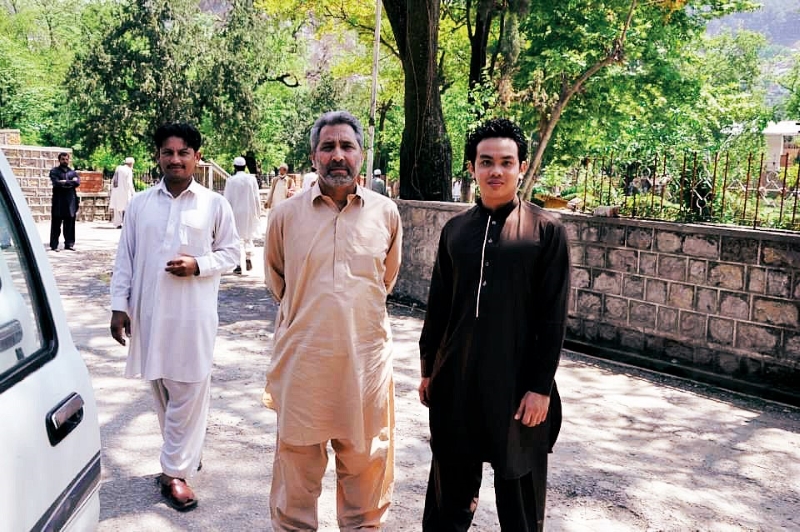
With Prof Nasim Khan, one of the foremost experts in epigraphy (Photo: Dr Nasha Rodziadi Khaw)
The quickly assembled team comprising PPAG USM staff and students worked diligently for the next five years. Their collective effort conducting geophysical surveys paid off when massive buried remains were detected.
“Our reconstruction of the paleoshoreline of the site proved that although Bukit Choras is currently located 8km from the water’s edge, it was coastline in ancient times. We also scientifically proved that the laterite blocks used as the primary building material were quarried from the foothill,” Nasha says.
The following three years, from 2022 to the present, are undoubtedly the most significant so far, though. He adds: “After carrying out detailed geophysical survey and paleoenvironmental analysis of the site for several years, we began to excavate it systematically. Our excavations in September 2023 and February 2024 revealed the well-preserved plinth of a Buddhist stupa with intricate architectural features, marked with the presence of projected niches facing cardinal points containing in situ stucco images of a meditating Buddha. I also discovered Sanskrit inscriptions in Post-Pallava script containing Buddhist text. Although there are already many Buddhist sites in the Bujang Valley, the Bukit Choras site, together with that of Sungai Batu, is the best preserved of all, with a complete assemblage of artefacts that can lead to important understanding of the history and culture of ancient Kedah.
“What is encouraging is the good state of preservation here, plus the complexity of the statues’ artistic forms and paleographic features of the inscriptions.
“The application of scientific, historical and sociological approaches in our research can further flesh out existing knowledge regarding the historical and cultural framework of Kedah Tua.”
In short, the studies and discoveries provide valuable new insights into the ancient kingdom, especially with regard to the pattern and distribution of settlement, cultural diffusion and sacred art, its socio-religious landscape, foreign relations as well as local material culture.
“This finding reaffirms ancient Kedah as part of the interconnected economic hubs in the ancient maritime world while presenting its society as an active recipient of foreign ideas in terms of religious ideologies and sacro-religious art,” Nasha remarks animatedly. “By contextualising the new data obtained in Bukit Choras with other findings in the Bujang Valley and around the region, the narrative of ancient Kedah as a complex multicultural society is strengthened. This also opens up possibilities for new research questions, especially in terms of cultural dynamics between the Indian Subcontinent and the coastal sites of the Malay Peninsula.”
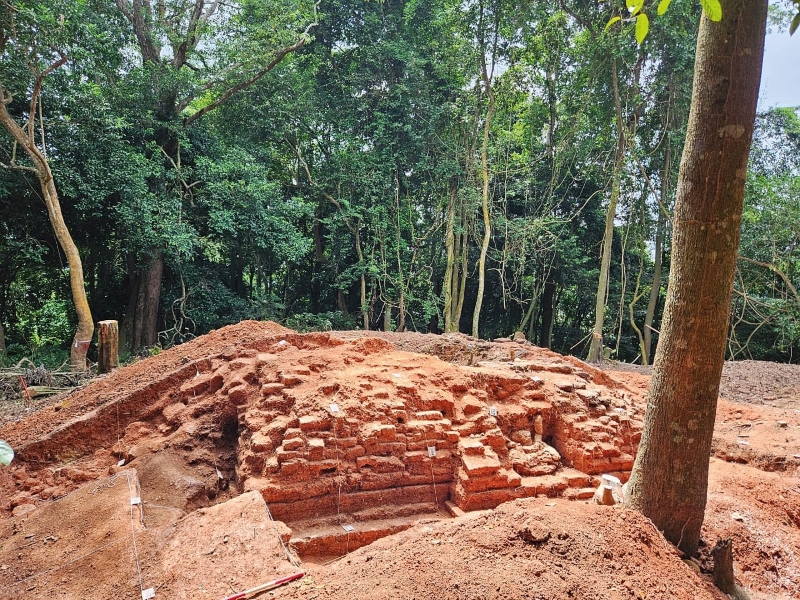
Part of the excavation site at Bukit Choras, Kedah (Photo: Dr Nasha Rodziadi Khaw)
Malaysia truly Asia
Looking ahead, it is, of course, in the nation’s best interests not just to preserve but also actively celebrate the treasures of our past.
“We definitely need and want more Malaysians to be interested in and proud of our local history,” asserts Nasha. “The idiom ‘history repeats itself’ is not without basis. More often than not, from time immemorial, human patterns of behaviour remain the same. The rise and fall of kingdoms and empires, the emergence and decline of cultures and societies, were all influenced by similar factors. The cyclical nature of history enables us to witness similarities between past and present and to learn from them.
“So, the best way to get people interested in history is to properly strategise the method with which we articulate the historical narrative. The narrative should be conveyed in a way that people are able to visualise and draw parallels between what we are experiencing today and what happened in the past.”
What is more important, however, is the simple fact that beyond Bukit Choras and the Bujang Valley, Malaysia from its very origins has always been a multicultural melting pot — a point to really take to heart in these divisive times.
“Material remains discovered so far suggest the presence of a multicultural society,” Nasha asserts. “Our excavations have already unearthed remains showing items of Indian, Chinese, Arab, Persian and indigenous heritage. This clearly shows that multicultural Malaysia was not something new, predating even the great Sultanate of Melaka. By correctly explaining these findings to the public, every Malaysian, regardless of race or background, can share the same sense of belonging, which will in turn further nurture their interest and curiosity. In short, the archaeological work in the Bujang Valley has a special advantage in attracting the interest of the average Malaysian, provided that research is done objectively, according to proper methodology and free of bias and ethnocentrism.”
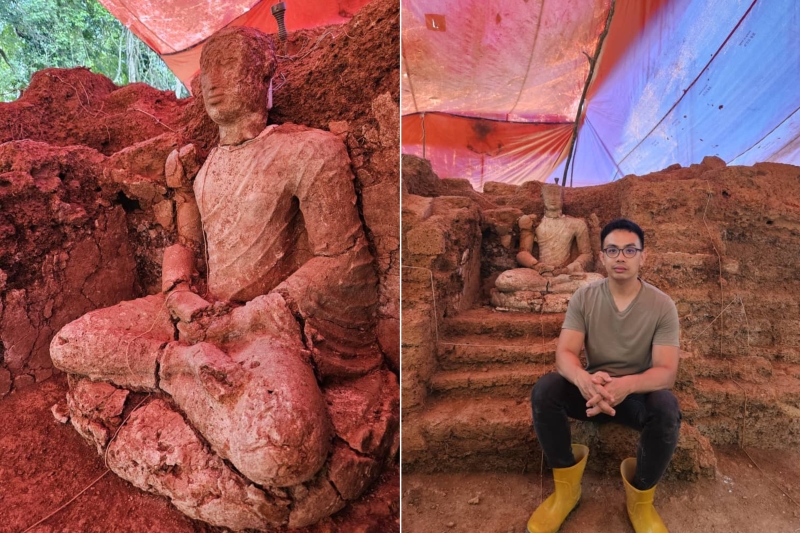
The studies and discoveries provide valuable new insights into the ancient kingdom (Photo: Dr Nasha Rodziadi Khaw)
Support + sustainability
Just as the past provides cautionary tales for the future, the findings of Bukit Choras and the Bujang Valley clearly show the advantages of a multicultural society. “It had a diversified economy; there was sustainable development and it showed how an ancient civilisation valued tolerance and was open and accepting of new ideas,” Nasha states.
Naturally, archaeological work cannot be done solo. Nor is it instant. Digs can take decades, teams are needed and funds are always necessary to keep things going. “Typically, there are five main stages to what we do: First is fieldwork and excavation, then laboratory analysis, artefact and site conservation, followed by community engagement and knowledge sharing programmes, and then academic and popular publication. Corporations and other bodies are welcome to assist in all these aspects of archaeological works in terms, something we truly appreciate.”
For the young dreamers inspired by the work that Nasha and his team are doing, he is quick to remind them that “archaeology is not a hobby but a lifetime commitment! It takes more than passion, interest and excitement for new things to become a true archaeologist. One needs to be mentally ready. Also, as mentioned, fieldwork and excavation constitute just a very small part of archaeological research. There is a lot more work to what we do than exploring exotic places”.
A key quote by Indiana Jones in Kingdom of the Crystal Skull is, “To be a good archaeologist, you gotta get out of the library.” But lest we forget, that is Hollywood. This is real life.
- Created on .
- Hits: 3159
